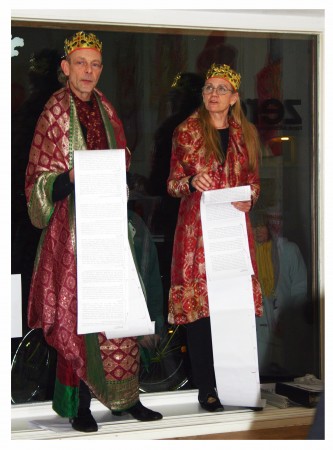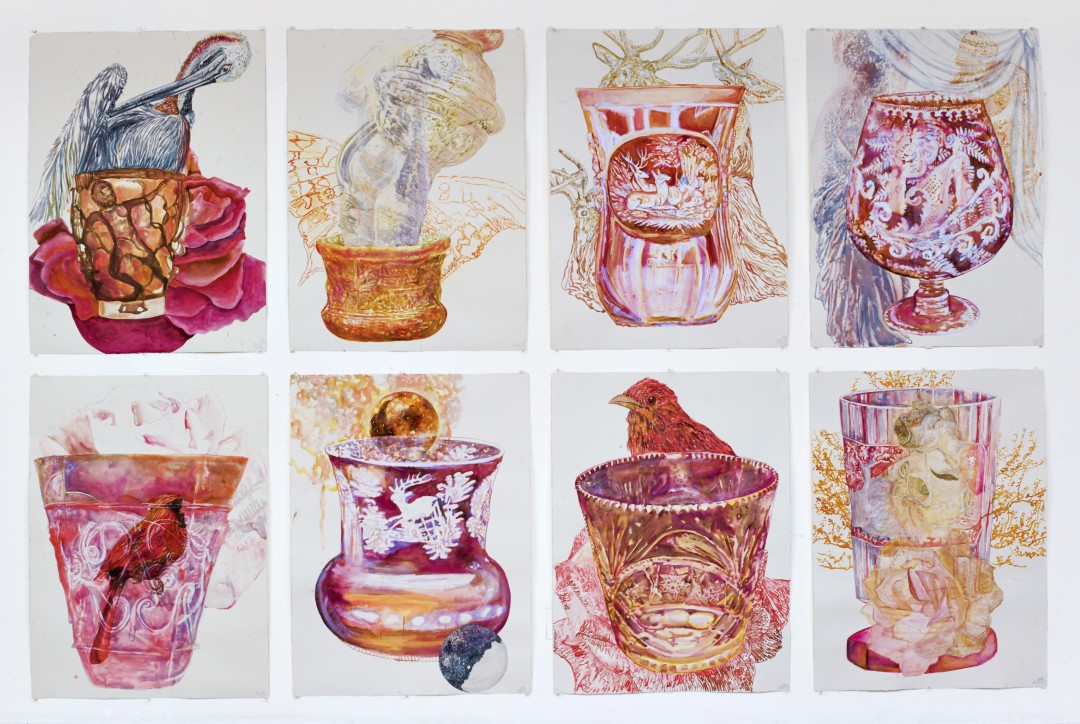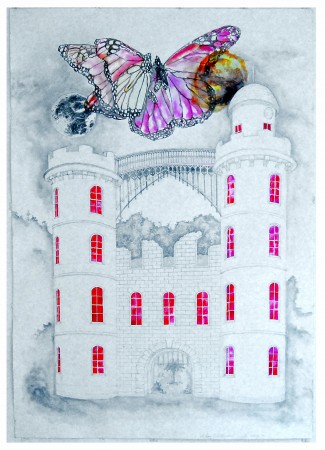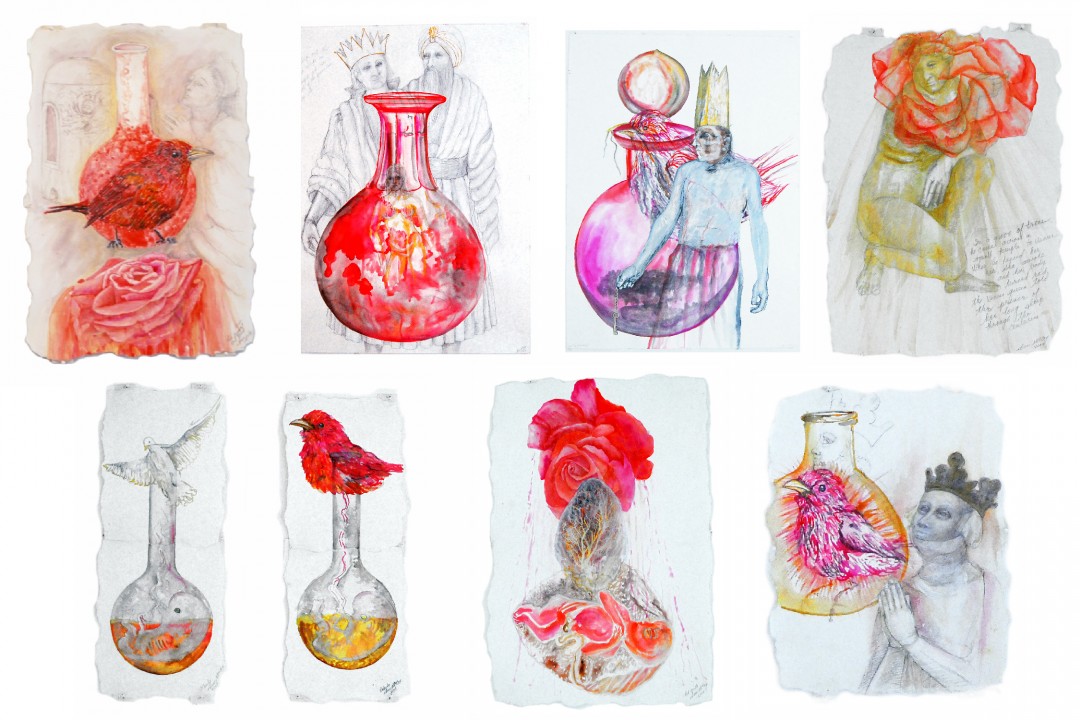The Transformation of the King and the Alchemist of the Pfaueninsel
Galerie Zero, Berlin, January 2008
http://www.zero-project.org/ann_mccoy.html
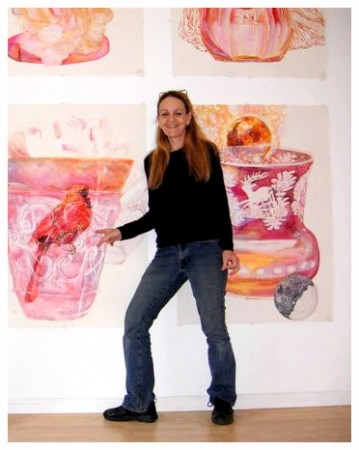
My fairy tale takes place on an island off Berlin called Pfaueninsel (Peacock Island). The island was the home of Johaan Kunckel and alchemist who made red glass. For me the Ruby Glass was a perfect symbol of the rubedo (the red stage if the alchemical process), when passion and pneuma, spirit and a devotion to the heart (feeling) enters the process. My fairy tale takes place during a period like the Hundred Year War. We are living in an age of perpetual war now. In some way my fairy tale suggests an answer to this dilemma.
In 2005 I began writing fairy tales with alchemical themes similar to “The Chemical Wedding of Christian Rosenkrantz”, written in 1459. For me, alchemical model is not antiquated and is much needed in our time. In alchemy, the shadow, our dark partner we project onto others, must be acknowledged and integrated. The pairs of opposites are brought together and transformed into a new third element. In our age of black and white thinking, with the shadow projected onto the Arab and others, this model provides a welcome change. Alchemy has to do with transformation, transmutation, and changes in the inner life which become manifest in the outer world. Without the transformation of the individual, there can be no transformation in the collective. Alchemy connects the inner transformation process through fantasy to the outer world.
My first exhibition featuring alchemical fairy tale themes was “The Death and Transformation of the Monkey King” at KHOJ in New Delhi. George Bush as a monkey king was put through an alchemical process of death and dismemberment and was baked in an oven and reborn in a golden egg as Hanuman the Indian monkey king. I adapted a third century Alexandrian alchemical recipe to transform a sick head of state into a divinity. Mary Renault uses this motif in her novel “The King Must Die.” An old king represents the ruling consciousness in a land. When the land becomes arid and the crops fail, the king is killed and buried in the fields. The new king (his son) represents a new perspective, which will bring fertility to the land.
After this exhibition I began writing fairy tales for our time, which included themes of both personal and collective transformation. The fairy tale is a powerful way to connect with the public and present alchemical models for change. I was also able to combine my writing with my art in a new way.
In 1977 when I was on the D.A.A.D. in Berlin, I visited Pfaueninsel, an island inhabited by a 16th century alchemist named Johaan Kunckel, who made ‘ruby glass”. Werner Herzog made a film about this red glass called “Herz aus Glas.” Kunckel chose the island with its limited access to insure secrecy for his alchemical process and also as a precaution against fire, glass works were notorious for starting fires and were put outside of city centers. Kunckel’s glass works did eventually burn down in 1693, but the island forever was associated with Kunckel’s alchemical mysteries. When I visited the island in 1977, shards of the red glass could still be found.
Pfaueninsel, a hundred years later. became a retreat for Frederich Wilhelm II and the Potsdam Court. His mistress Grafin Lichtenau supervised many of the plans for a castle, a game park, rose gardens and pavilions for musical and theatrical pleasures. Thousands of plants including exotic palms for the Palm House and animals were brought in to create a South Sea fantasy for the court. The island was created as a natural paradise on the model of Rousseau. A zoo with peacocks gave the island its name.
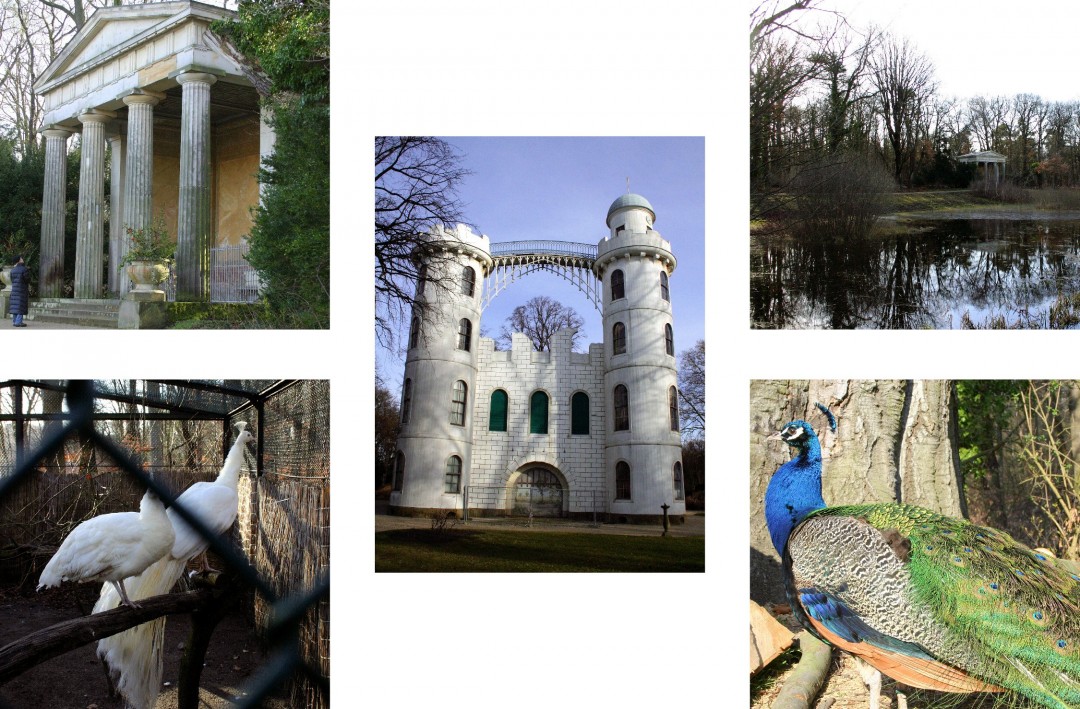
The various elements present in the history of the island fascinated me and I began to write a fantasy history of the island using these historical elements as a basis for my fairy tale. The rose garden, the peacock, the furnace, and the island appear in many alchemical texts. These alchemical themes were also present on Pfaueninsel in structures developed by the court Rosicrucian Christoph von Wolner who was instrumental in the planning of the Neuer Garten, and Jacob’s Well, Temple of Serapus and placement of statues like Dianna of Ephesus on Pfaueninsel. This Rosicrucian influence was prevalent in German courts such as Frederick and Elizabeth’s at Heidelberg in the Papatinate from 1613 onwards.
I have condensed several hundred years of the island’s history into a fairy tale about a King, his mistress, and an alchemist. Two important German fairy tales steeped in alchemical symbolism would be models for my tale: “The Chemical Wedding of Christan Rosenkreutz” by an unknown author, and Goethe’s “Fairy Tale of the Green Snake and the Beautiful Lily.”
The fairy tale will hopefully be performed either on the island or in a Baroque theatre like the theater at Potsdam this coming summer. A video could also be shot of this performance. Actors from New York’s THEATERLAB and the Berlin group OPENSPACE will perform the fairy tale.
I would use the Pfaueninsel Castle as a screen and project a series of images from my dreams on the castle façade. I teach projection at Yale in the School of Drama. The performance would combine my written fairy tale, my work in projection, and the talents of the actors.
I have spent thirty years reading alchemy both in Rome and in Zurich. I worked with C.G. Jung’s main heir Dr. C. A. Maier in Zurich for twenty -five years doing studies in depth psychology and alchemy. When I was on the Prix de Rome, I read alchemy at the Vatican Library and the Palazzo Corsini. My main interest is late German alchemy, mainly Michael Meier, the founder of the Rosicrucian Order. The island was a Rosicrucian and alchemical fantasy. I want to use it like a stage set for my alchemical fairy tale.
The Ruby Glass
2008
Eight part series
Watercolor and pencil on paper
45” by 35”
Pfaueninsel Castle
2008
Watercolor and pencil on paper
60 by 42 inches
First row from left to right:
The Uniped, King, and the Moor. 2008, 62 by 42 inches, watercolor and pencil on paper
The Black King Meets the Red Bird, 2008, 62 by 42 inches, pencil and watercolor on paper
The Queen and The Red Bird, 2010, 15 by 11 inches, pencil and watercolor on paper
Venus, 2008, 11 by 15 inches, pencil and water color on hand made paper
Second row from left to right:
Rubedo, Albedo, 2008, 11 by 7 inches, each, watercolor and pencil on hand made paper.
Alchemical Birth, 2008, 17 by 11 inches, watercolor on hand made paper
The Queen and the Red Bird, 2008, 9 by 7 inches
